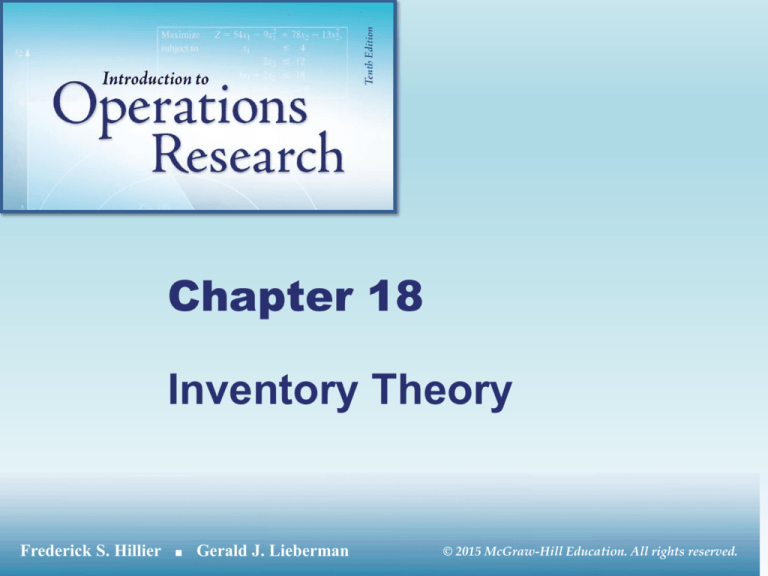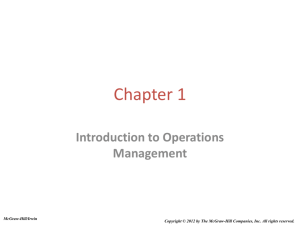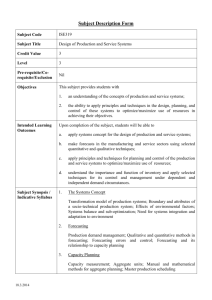
Chapter 18
Inventory Theory
Frederick
S. HillierEducation.
∎ Gerald J. Lieberman
© 2015 McGraw-Hill
All rights reserved.
© 2015 McGraw-Hill Education. All rights reserved.
Introduction
• Scientific inventory management
– Mathematical model describes system
behavior
– Goal: optimal inventory policy with respect to
the model
– Computerized information processing system
maintains inventory level records
– Apply the inventory policy to replenish
inventory
© 2015 McGraw-Hill Education. All rights reserved.
2
Introduction
• Demand
– Number of units that will need to be withdrawn
from inventory
• Deterministic inventory model
– Used when demand is known
• Stochastic inventory model
– Used when demand cannot be predicted well
© 2015 McGraw-Hill Education. All rights reserved.
3
18.1 Examples
• Example 1: manufacturing speakers for TV
sets
– One speaker needed per TV set
• Sets manufactured on continuous production line
– Speakers produced in batches
• $12,000 setup cost per batch
– $10 unit production cost of a single speaker
– $0.30 per month holding cost per speaker
– $1.10 per month shortage cost
© 2015 McGraw-Hill Education. All rights reserved.
4
Examples
• Example 2: wholesale bicycle distribution
– Distributor purchases a specific bicycle model
from the manufacturer and supplies it to
various bike shops
– Demand is uncertain
– Ordering cost includes administrative cost of
$2000 and unit cost of $350 per bicycle
– $10 per bicycle holding cost
– $150 per bicycle shortage cost
© 2015 McGraw-Hill Education. All rights reserved.
5
18.2 Components of Inventory Models
• Cost of ordering z units
– Includes a static cost and a cost per unit
• K is the setup cost and c is the unit cost
• Holding cost
– Represents all costs associated with holding a
unit in inventory until it is sold or used
• Cost of tied-up capital
• Space
• Insurance
• Protection
© 2015 McGraw-Hill Education. All rights reserved.
6
Components of Inventory Models
• Shortage cost
– Also called unsatisfied demand cost
– Cost incurred when demand exceeds
available stock
• Backlogging: demand not lost but delayed
• No backlogging: orders are canceled or met by
priority shipment
– Revenue may or may not be included in the
model
© 2015 McGraw-Hill Education. All rights reserved.
7
Components of Inventory Models
• Salvage cost
– Negative of the salvage value
– Included in the holding cost
• Discount rate
– Accounts for the time value of money
• Classification of inventory model based on
how often inventory is monitored
– Continuous review
– Periodic review
© 2015 McGraw-Hill Education. All rights reserved.
8
18.3 Deterministic Continuous-Review
Models
• Economic order quantity (EOQ) model
– Stock levels are depleted over time
• Replenished by a batch shipment
• Basic EOQ model assumptions
– Demand rate is constant at d units per unit
time
– Order quantity Q to replenish inventory levels
arrives all at once when inventory drops to 0
– Planned shortages are not allowed
© 2015 McGraw-Hill Education. All rights reserved.
9
Deterministic Continuous-Review Models
• Reorder point equals demand rate times
lead time
© 2015 McGraw-Hill Education. All rights reserved.
10
Deterministic Continuous-Review Models
• Components of total cost per unit time T
– Production or ordering cost per cycle, 𝐾 + 𝑐𝑄
– Holding cost per cycle,
ℎ𝑄 2
2𝑑
• Total cost per unit time
• Value of Q, Q* that minimizes T
© 2015 McGraw-Hill Education. All rights reserved.
11
Deterministic Continuous-Review Models
• Cycle time, t*
𝑡 ∗=
2𝐾/𝑑ℎ
• For the speaker example:
© 2015 McGraw-Hill Education. All rights reserved.
12
Deterministic Continuous-Review Models
• The EOQ model with planned shortages
– Third assumption of basic EOQ model is
replaced:
• When a shortage occurs, the affected customers
will wait for the product to become available again.
Backorders are filled immediately when order
quantity arrives to replenish inventory
• The EOQ model with quantity discounts
– New assumption:
• Unit cost now depends on batch quantity
© 2015 McGraw-Hill Education. All rights reserved.
13
Deterministic Continuous-Review Models
© 2015 McGraw-Hill Education. All rights reserved.
14
Deterministic Continuous-Review Models
© 2015 McGraw-Hill Education. All rights reserved.
15
Deterministic Continuous-Review Models
• Different types of demand for a product
– Independent demand
• Bicycle wholesaler experiences this type of
demand
– Dependent demand
• In the TV speaker example: speaker demand
varies with TV set demand
• Material requirements planning (MRP)
– Technique for managing inventory of
dependent demand products
© 2015 McGraw-Hill Education. All rights reserved.
16
Deterministic Continuous-Review Models
• Just-in-time (JIT) inventory management
– Emphasizes reducing inventory levels to the
bare minimum
• Providing items just as they are needed
– Focuses on finding ways to reduce setup
costs so that order quantities can be small
© 2015 McGraw-Hill Education. All rights reserved.
17
18.4 A Deterministic Periodic-Review
Model
• When demand varies from period to period
– EOQ formula no longer ensures a minimum
cost solution
• Objective: minimize total cost over n
periods
• Fixed costs are independent of the
inventory policy
– Minimize total variable costs over the n
periods
© 2015 McGraw-Hill Education. All rights reserved.
18
A Deterministic Periodic-Review Model
• Example given on Pages 815-817 of the
text
• An algorithm for an optimal inventory
policy
– An optimal policy produces only when the
inventory level is zero
© 2015 McGraw-Hill Education. All rights reserved.
19
18.5 Deterministic Multiechelon Inventory
Models for Supply Chain Management
• Echelon
– Each stage in a multi-stage inventory system
• Supply chain
– Network of facilities that take raw materials
and transform them into finished goods at the
customer
– Includes procurement, manufacturing, and
distribution
© 2015 McGraw-Hill Education. All rights reserved.
20
Deterministic Multiechelon Inventory
Models for Supply Chain Management
• A model for a serial, two-echelon system
– Seven assumptions in this model outlined on
Page 822 of the text
• Echelon stock
– Stock physically on hand and downstream at
subsequent echelons
© 2015 McGraw-Hill Education. All rights reserved.
21
© 2015 McGraw-Hill Education. All rights reserved.
22
Deterministic Multiechelon Inventory
Models for Supply Chain Management
• Optimizing the two installations separately
– A flawed approach
– Choosing order quantities for installation 2
must account for the resulting costs at
installation 1
• Optimizing the two installations
simultaneously
– Correct approach
– Process outlined on Page 826-827 of the text
© 2015 McGraw-Hill Education. All rights reserved.
23
Deterministic Multiechelon Inventory
Models for Supply Chain Management
• Model for a serial multiechelon system
– Six assumptions outlined on Page 828 of the
text
– Difficult to solve for n > 2
– Simplifying approximations normally made to
derive a solution
• Roundy’s 98 percent approximation property
© 2015 McGraw-Hill Education. All rights reserved.
24
© 2015 McGraw-Hill Education. All rights reserved.
25
Deterministic Multiechelon Inventory
Models for Supply Chain Management
• Extension of serial multiechelon model can
be formulated for a distribution system
© 2015 McGraw-Hill Education. All rights reserved.
26
18.6 A Stochastic Continuous-Review
Model
• Traditional method: a two-bin system
– All units for a particular product held in two
bins
– Capacity of one bin equals the reorder point
– Units first withdrawn from the other bin
– Emptying second bin triggers a new order
• Newer approach: computerized inventory
systems
– Current inventory levels are always on record
© 2015 McGraw-Hill Education. All rights reserved.
27
A Stochastic Continuous-Review Model
• Inventory system based on:
– Reorder point, R
– Order quantity, Q
• Inventory policy: whenever inventory drops
to R units, place an order for Q more units
• Ten model assumptions outlined on Page
839 of the text
© 2015 McGraw-Hill Education. All rights reserved.
28
A Stochastic Continuous-Review Model
• Choosing the order quantity, Q
– Use formula for EOQ model with planned
shortages
• d is the average demand per unit time
• See assumptions for definitions of K, h, and p
© 2015 McGraw-Hill Education. All rights reserved.
29
A Stochastic Continuous-Review Model
• Choosing the reorder point, R
– Based on manager’s desired level of service
to customers
• Alternative measures of service level
– Probability that a stockout will not occur
between the time an order is placed and when
the order quantity is received
– Average number of stockouts per year
© 2015 McGraw-Hill Education. All rights reserved.
30
A Stochastic Continuous-Review Model
• Alternative measures of service level
– Average percentage of annual demand that
can be filled immediately
– Average delay in filling backorders when a
stockout occurs
– Overall average delay in filling orders
• Where delay without a stockout is zero
© 2015 McGraw-Hill Education. All rights reserved.
31
A Stochastic Continuous-Review Model
• Measure 1 is most convenient to use
• Procedure for choosing R under service
level measure 1
– Choose L
– Solve for R such that 𝑃(𝐷 ≤ 𝑅) = 𝐿
• Example given on Page 841 of the text
© 2015 McGraw-Hill Education. All rights reserved.
32
18.7 A Stochastic Single-Period Model for
Perishable Products
• Stable product
– Will remain sellable indefinitely
• Perishable product
– Can be carried in inventory only a certain
amount of time
– Single period model is appropriate in this case
– Types of perishable products
• Newspapers, flowers, seasonal greeting cards,
fashion goods, and airline reservations for a
particular flight
© 2015 McGraw-Hill Education. All rights reserved.
33
A Stochastic Single-Period Model for
Perishable Products
• Seven assumptions of the model
– Given on Pages 846-847 of the text
• Analysis of the model with no initial
inventory and no setup cost
– Simplest case to consider
– See Pages 847-849
– Application to the bicycle example
• Analysis extends to include setup cost and
initial inventory levels
© 2015 McGraw-Hill Education. All rights reserved.
34
18.8 Revenue Management
• Airlines started using revenue
management in the late 1970s
• Overbooking
– One of the oldest and most successful
revenue management practices
• Revenue management in the airline
industry today
– Pervasive, highly developed, and effective
© 2015 McGraw-Hill Education. All rights reserved.
35
Revenue Management
• Model for capacity-controlled discount
fares
– Decision variable: inventory level that must be
reserved for highest-paying customers
– Key to solving: marginal analysis
• An overbooking model
– Choose overbooking level to maximize profit
– Shortage cost (denied-boarding cost) is
incurred if overbooking level is too high
© 2015 McGraw-Hill Education. All rights reserved.
36
18.9 Conclusions
• Models presented in this chapter illustrate
the general nature of inventory models
• EOQ models have been widely used
• Stochastic single-period model is
appropriate for perishable products
• Multiechelon inventory models play an
important role in supply chain
management
© 2015 McGraw-Hill Education. All rights reserved.
37





